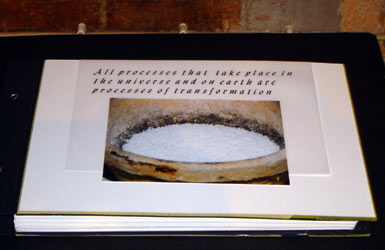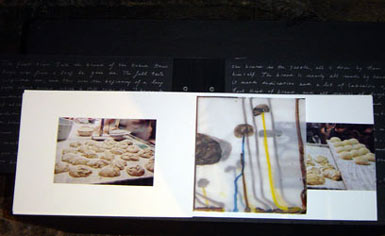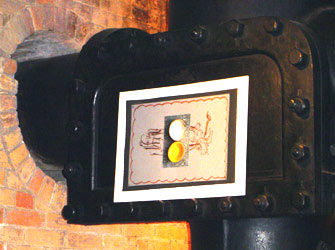
____________________________________
____________________________________

Once I found a honeycomb under an iron barrel in the garden. When I saw it laying there on the ground, I thought it a miracle of structure and form. I picked it up and became aware of the skill these bees must have to produce a thing like this. The bees are really extraordinary good craftsmen. I am educated with the idea that art and craft are two different things: art should be something high and craft something low. In our society the distinction between craft and art is still commonly accepted, art is seen as something far above everyday life, while craft is linked with practical skill and the function of the object.
There are many reasons that art has a status superior to craft; one of them is the difference in importance formerly given to mens work and to womens work. Nowadays the difference in importance is based upon a more philosophical reason: an artist is free to oppose by his work against or to react upon society, while a craftsman is not free, and has to accept the commands that he gets.
How close art and craft can come together I discovered when I met the baker Hans Boyn in the south of Portugal. He is a professional baker who bakes all kinds of traditional bread, like carobbread, pumpkinbread, cornbread, ryebread, barleybread, onionbread etc. The way he works and thinks shows a resistance against the industrial way of baking bread, and mass production of food in general. Industrial made bread has no taste and is as he calls it "a dead product".
Nowadays in Northern Europe there are many bakers who do not accept the dead product of mass production. But mostly they find their clients in the higher class of society and the price of the bread is rather high. In Portugal there are still many small bakers, but the supermarkets overrule them by selling industrial produced bread. For Hans Boyn, a small baker, the question is: How can I bake a good bread for a reasonnable price, so that many people can eat a tasteful and wholesome bread. To realize this he has to accept low working conditions and to work six days a week. The film-director Godard once said that most people prostitute themselves to earn their living: they spend a lot of time in their life doing work in which they are not involved, or which they even dislike. For the baker Hans Boyn it would be impossible to work in the industrial food-production, in which for exemple a machine can produce 70.000 rolls an hour.
His way of being a craftman has much in common with the mentality of an artist like for exemple the german artist Wolfgang Laib. Both reject the way our society spills its life-force.


The materials Laib is using to create his works are: pollen, rice, milk and beewax. These are all essential materials who represent life-force. Laib says: "all these materials have an incredible energy which I myself could never create". For his works made with pollen of hazelnut, Laib has to collect several months to fill half a jar with this material. He dedicates himself to the harvesting process which starts in February and continues through September. Laibs artistic activity is a slow process, like the pollen-gathering of the bees. Laib says: "Today, in our culture everything has to be accessible, touchable and available. And before, in all primitive culture things were handed with much more reverence". His work is based on personal and sensual contact with these materials , it is placed directly on the ground, in simple shapes. He presents creations that are made by nature itself, and tries by this activity to come into contact with the life-force of nature.
Like Laib , Hans Boyn works with natural products out of the region were he is baking. He never uses prefabricated materials or instant products as is done in the food industry.

In the dark room of the bakery reigns the slow time of natural processes, and not the quick time of economic processes. There is the time necessary to heat the oven, which needs four hours, there is time for the sourdough which takes a night, there is time for the dough to rest, to swell, to get shape and to be baked. In the middle-ages there was a saying: "the sourdough is like a breath, which brings the dough to life" and the ovenhouse was compared to a womb. This kind of language shows clearly how the making of bread was seen as a proces of giving life, of being in contact with natural materials and processes. For making good food this contact with natural materials, and the slow proces of producing is essential. By this reason much has to be done by hand, except for the kneading of the dough. There are many other artists who react by their work on this loss of balance between nature and culture. One of them is Louis Leroy. His work is not exposed in galleries or musea. He is a cultural philosopher and artist. He opposes against the way nature is subordinated to the process of consumption in our society. In his artworks he wants to make visible processes in nature over a long period of time. His last project, on four hectares in the north of Holland and on which he is working already thirty years, is called the Eco-Cathedral. With the material of broken-off buildings he has started to build a network of stone constructions. Nature is allowed to grow over them, nature he says is not a trimmed gazon with some red flowers in a corner on black earth, but is a process in which all things have only meaning if they make this process possible. When I visited the place of this project, I had to ask for the way in the village. The people were wondering why I wanted to visit this place full of rubbish. Indeed, Leroy must not be seen as a gardener, time is one of his working-mates. He resists vehemently against the idea that one should control nature and restrain its potential. In his opinion digging is a waste of energy and chaos must be admitted. Everything in nature he says is in a constant proces of transformation. Time makes this visible.
Nowadays there are many artists reacting upon the kind of progress we live in, not that they do oppose to progress in itself, but they try to give it a form which is not only dictated by economics.
Laib and Leroy manifest by their work the necessity to stay in contact with nature and its life-giving processes of transformation. In the same way bakers like Hans Boyn step, for making their bread, into the dynamic process of the transformation of natural materials. However their products cannot be called art, they have a lot in common with artists: all of them show resistance against the commonly accepted production processes of our economy, all of them try to come again into contact with the life-giving processes of nature, all of them want to give form to a future with more human values.

I think art and craft can come together in mentality and in vision upon society. Craftsmen and artists can make other people aware by their attitude of the dumb way of living our economy often forces us to.
In our culture a baker has a modest place in society. But since I met the craftsman Hans Boyn and cooperated with him to make my book about bread, the opinion I had about the state of a baker changed a lot. I learned that working with real materials, who are connected to life - like flour, water, salt and honey - and feeding other people by your work is something of really high importance.
____________________________________